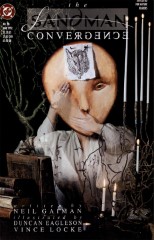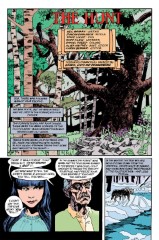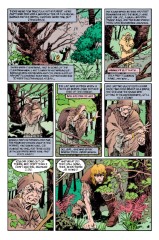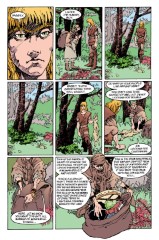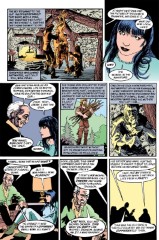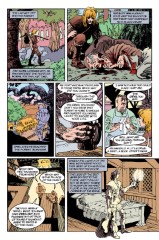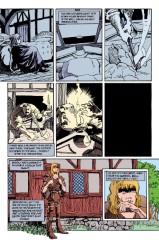Issue 38: "The Hunt"
Neil Gaiman, Duncan Eagleson, and Vince Locke
- First story in anthology, Convergences
- Fourth story reprinted in trade paperback Fables & Reflections
- Audible Act II Chapter 18
Themes: Convergences is about storytelling, as is Sandman overall. In particular, Convergences tells tales where the storyteller becomes the story, and where reality intersects with story and with fantasy. And, it may be noted, dreams are where reality and fiction converge.
A common thread among the stories is the intersection (or convergence) of characters with their own divergent lives. Another is the passage from the familiar to the unfamiliar, as happens to the central character in each story. Also, in each tale, the central character is not a native to the Dreaming but visits a portion of it, and encounters a native of the Dreaming, in the process of the tale. One may also note the role of time in each tale, with some aspect of different times converging.
In "The Hunt", Vassily passes from the comfort of his forest to the unknown outside world, and, indeed, from the Old World into the New. The past is seen in the tale of long ago, the present in the telling of the tale, and the future in Celeste's relationship with Christopher. Value plays an important, if ambiguous, role in "The Hunt". To various characters, value is in dreams; the eye of the beholder, or of the dreamer; or in experience. All these disparate ideas converge in the final word on the subject: a woman who "knew the value of things" though we are not told how value could be known; perhaps we are to believe that value may be defined in all these ways.
Page 1#
Panel 1
Old Country: Immigrants to America are often portrayed as referring to their original homeland as the Old Country.
Palaver: From Portuguese palavra (originally from Latin, of course), meaning talk, conversation, particularly at length or with little content.
Panel 3-4
Chrissakes: Christ's sake. The Christian religion holds that it is a sin to take their god's name in vain, although this is a sin observed more often in the breach than in the keeping. It is also a tradition that the holy name has power over those with magic in their blood.
The storyteller and his granddaughter have made no appearances other than this story.
Panel 5
Asafoetida: Also asafetida, a highly scented, dark yellow gum resin with a bitter acrid taste obtained from the roots of several plants of the genus Ferula found in Central Asia. Some species of Ferula are found in the Mediterranean area as well, but these are not noted as yielding asafoetida. The plants are typically tall with divided leaves. Ferula are umbelliferous, related to carrots, celery, parsnips, and herbs such as parsley. The word is from medieval Latin asa, "gum" (a borrowing from Persian "aza") + fetida, "stinking".
Asafoetida is the primary flavoring ingredient of Worcestershire sauce, along with anchovies. It is also used to test the responses of infants, since its odor is an inducer of lachrymose behavior patterns. (It makes babies cry.)
Like the highly scented garlic, asafoetida is traditionally a repellent of vampires and/or werewolves.
Burial at a crossroads is traditionally a method of ensuring that the undead do not rise again to torment the living. One tradition holds that the rising undead will not know which way to go upon rising and cannot leave the crossroads; an alternate tradition holds that crossroads are sacred grounds, due to their shape.
Panel 6
MTV: An American cable network with affiliated networks around the world that primarily plays music videos.
Page 2#
- Real forests, true bears, true wolves: Akin to Platonic forms, the creatures and places in stories are the true essence of the creature or place, without the rounded-off corners or the compromises required of things that exist. A wolf such as you might meet is hardly more than a dog who has not forgotten how to hunt; a wolf such as you might hear about is a shaggy beast, born to the hunt, little more than hunger and fangs and burning eyes, a creature who might someday hunt you.
Page 3#
Panel 1
True folk: see above.
Panel 2
We infer that the taleteller's name is also Vassily.
Panel 4
The gypsies, or Romany, as they are said to call themselves, are a nomadic European people of a common stock. In tales, they are fortune-tellers, traders, and thieves; bewitching beauties who may steal a man's eye while their cousin steals his purse, or his babe. Heed a gypsy's warning, and beware the curse of a gypsy wisewoman.
Page 4#
Panel 1
Note Vassily's eyes, which here suggest the vertical pupils of a cat. The granddaughter's eyes from pages 1-2 may also suggest this form.
Panel 5
Note Vassily's skill in hunting.
Panel 8
Koschei: From the Dictionary of Mythology, Folklore, and Symbols (Jobes, 1961), Koschei is an evil, immortal Slavic spirit with a secret weakness (presumably that he kept his life in his heart), finally slain by a hero. He is compared to the Shinto spirit-snake Koshi, the Minotaur of Greek myth, and Jormungandr, the Midgard Serpent of Norse myth.
The Facts on File Encyclopedia of World Mythology and Legend (Mercatante, 1988) notes:
In Russian folklore, an evil wizard whose soul is hidden in a duck's egg. Though often called deathless or immortal, Kostchei could die if one could find where the egg that contained his soul was hidden. If the egg was destroyed Kostchei also would be destroyed. In Stravinsky's ballet L' Oiseau de feu (The Firebird) Ivan, the hero, finds the egg in the hollow of a tree and destroys it, causing Kostchei and his evil court to disappear forever. Kotstchei appears in James Branch Cabell's novel Jurgen. Variant spellings; Koschey, Katschei.
The Red Fairy Book recounts a tale wherein Koschei is killed when his head is struck by a horse, a horse the hero received from Baba Yaga. After Koschei's head is cracked, the hero removes his head and burns it. In one version of the story, Koschei is the king of the snakes. No refs on the Cloak of Night. The Drum Inescapable is also referred to in Books of Magic, Book III, page 27, panel 6. A wyvern is a draconian creature; one guards the center of the Dreaming. Yggdrasil is the World Oak of Norse myth. In hunts, assistants beating drums are often sent to drive quarry before them so that the huntsmen may slay them with less of a chase; thus, the significance of the Drum Inescapable.
Page 5#
Panel 2
Gaje': From context, the Romany word for outsider.
Panel 5
Here, "The People" is likely distinct from "True Folk" and possibly akin to "The Family" of page 1 panel 1.
Panel 9
Value's in Dreams: A convergence.
Page 6#
Panel 3
Pskoff: (Also Pskov) A lake and a city in the European part of Russia. Vyatka: Former name of Kirov, another city in the European part of Russia.
Panel 7
The gypsy is not reacting to Vassily's hands, which are normal as far as I can tell, but to what she sees in his eyes.
Panel 8
The gypsy is making the sign against the evil eye with her left hand, and the sign against the devil with her right.
Page 7#
Panel 5-6
I have no idea what the small bone carved into the shape of a small bone means. Perhaps a charm of some sort? The wooden finger-ring makes its second appearance.
Panel 7
Celeste: From Latin meaning "heavenly".
Michael Jackson: A pop star whose popularity with teen culture waxes and wanes in an unpredictable fashion; also noted for his eccentric habits, his androgyny, and his extensive plastic surgery.
Page 8#
Panel 1-2
Vassily did not slay the peddler woman, nor was she eaten by a beast, nor was her pack taken by bandits. Who, then, killed her? Perhaps Vassily's father?
Panel 4
Forest is home to ghouls and ogres: Ironic, considering what transpires in the inn.
Panel 5
Note the book.
Page 9#
Panel 1-3
It is traditional for heroes to be beset by monsters while on the road, and the villainous innkeeper is a staple of the genre.
Panel 7
Note the valuable lesson.
Panel 8
Considering that the inn's fare was characterized as "poor" on the preceding page, we are probably meant to infer that Vassily -ate- the villainous innkeeper. Note that Vassily is wiping his mouth.
Page 10#
Panel 1
This is certainly Lucien, Dream's factotum and librarian, among other duties.
Panel 2
Note the remark on the definition of value.
Panel 6
This is the traditional tale of Koschei.
Page 11#
Panel 3-5
The old man believes in fairies, is more than a century and a half in age, and can rip his granddaughter's throat out with his teeth. The storyteller becomes the story.
Post-modern: At least one definition proclaims this to be a style which consciously uses complex forms with allusion to historic styles. Its application to this story, or to Sandman as a whole, is left as an exercise to the literary critics.
Panel 6
Raven: Probably Lucien has employed one of Dream's earlier raven-companions to aid him.
Page 13#
Panel 5
Note Vassily's teeth, as well as his eyes.
Page 14#
Panel 7
Again, "The People". Note the figure in the lower right who seems to be in a semihuman shape. Is the figure behind the fire of superhuman height?
Page 15#
- Baba Yaga is a witch from traditional Russian tales. She has iron teeth, lives in a hut which has chicken legs, and flies across the night sky in a mortar which she drives with a pestle. She is a great sorceress and, generally, evil. Baba Yaga, or a facsimile thereof, appears in Books of Magic, Book III.
Page 16#
Panel 5
This glass heart of an immortal bares an uncanny resemblance to the glass heart Rose handed Unity in #16:14
Page 17#
Panel 2
Trust the story-teller: Contemplate this, too, as you contemplate the depth of this tale. If the story-teller tells you not to trust him, may you trust his word in this?
Panel 3
Scented powder was used to cover up body odor in eras past when folk did not bathe often.
Panel 4
Men and women, it is said, are driven stark mad by the light of the full moon.
Page 18#
Panel 4
Cold iron traditionally has power over those with magic in their blood (particularly the Faerie folk).
Panel 7
True Death: A storyteller's kind of death, as with the true wolves, or a death final enough to snuff the soul with the body? Or perhaps The People may pass through more than one kind of death, since the gypsy woman's death was not notable enough to be called the True Death.
Page 19#
Panel 2
There are rules to magic, and to the Dreaming, and one of them apparently holds that Lucien cannot steal, but may only purchase.
Panel 3
Note that Lucien's glasses seem to distort his face, increasing the apparent size of his features, indicating farsightedness, a curious ailment for a librarian. Compare with his appearance on page 10, panel 6, where his glasses seem to be of the opposite prescription (note the curve of his face, not the size of his eyes).
Panel 5
The continents indeed do move, as the scientists say, although this could not be known to Vassily, who may even be ignorant of the concept of continents. In any case, the continents have been roughly in their current shapes for many millions of years, so the last thief Lucien refers to could not have been an ordinary human (although Brief Lives, the subsequent storyline, indicates that seemingly human beings have been around for much longer than commonly believed).
Panel 7
Dwarrow, nightgaunt: "Dwarrow" is probably a variant of the dwarves (dvergar, in Old Icelandic) of Norse myth. "Nightgaunts", faceless flying humanoid servants of the god Nodens, appeared in stories by H.P. Lovecraft, an early horror author. In particular, they may have appeared in "The Dream-Quest of Unknown Kadeth". They tickled people into submission and could transport them to "the Dreamlands", a Lovecraftian analog to the Dreaming.
Again note Vassily's teeth and eyes.
Page 20#
Panel 7
Newfound habit: Ordinarily, it takes two occurrences to mark a "habit", but Dream may be indulging in sarcasm. Note also that he is dressed in what appears to be formal wear; prior to his capture, he always dressed in clothing appropriate to the highest stratum of society and to his audience.
Page 21#
Panel 3
Dream is not unsympathetic to the young man, for he is as besotted by romance. Dream's realm is one of imagination, and Dream takes precedence over Desire when the object of desire is constructed from imagination, as in Vassily's case.
Panel 5
The Merrie Comedie of the Redemption of Doctor Faustus, by Christopher Marlowe: Marlowe's most famous work concerns the fall of Doctor Faustus, who sought a long life at the cost of his soul. This is clearly a sequel, one which Marlowe may in fact have planned but never written. Recall that Lucien's library is a library of works never completed. Marlowe appeared in The Doll's House, in "Men of Good Fortune".
Page 22#
Panel 1
I am told by ladyfriends of mine that menstruation is often accompanied by dreams of blood, though that is certainly not the only possible cause for this dream.
Panel 6
Tokay: An aromatic wine, made in the region around the town of the same name in Hungary.
Page 23#
Panel 2
Finally, a hint into the nature of The People; a clan of shapechangers or lycanthropes.
Panel 3
An adequate description of the mating rituals of a variety of mammalian carnivores.
Panel 5
Sexist: The sexism of the story is weak and of the second order, but lies in the role of the Duke's daughter as prize, and the power of Vassily to choose his woman; the important sorts of power, to make life's choices, lie with men. This is filtered through a modern perspective, wherein the Duke's daughter does not scream or faint when confronted with strange men in her bedroom, and where a woman of the People may be a better hunter than a man, but the sort of sexism endemic in fairy tales remains.
Page 24#
Panel 2
Novaya Zemlya: Two islands north of the Russian mainland, inside the Arctic Circle. The islands are virtually uninhabited, so I doubt Celeste is seriously claiming that The People are from there; probably she just named the first Russian wilderness that came to mind.
Panel 4-5
Celeste is manifestly wrong about the story, as the storyteller is right (and lit-crits be damned!)
Panel 6
Another reference to value. Note the grandfather's eyes are the same as Vassily's. The storyteller becomes the story.
See also
Vassily's daughter appeared in an unpublished story, Marquee Moon. More info can be found here.
Credits
- Originally collated and edited by Greg Morrow.
- Lance Smith (lsmith@cs.umn.edu) reported a vast database on Koschei's significance, noted some traditions about crossroads, imagined shapes in a little girl's eye, agreed with me about ravens, noted changelings, cited nightgaunts, and wondered about Lucien's optometrist.
- The Theme Team consulted on the literary deconstruction ofConvergences, and consisted of:
- David Pautler (pautler@ils.nwu.edu)
- Lance Smith (lsmith@cs.umn.edu)
- Enrique Conty (jester@ihlpm.att.com)
- Chuck Jordan (jordan@castor.cs.uga.edu)
- Andrew Moran (andrew@cs.chalmers.se)
- Deborah Ginsberg (debg@uxa.cso.uiuc.edu)
- Robert A. Carlin (carlinra@ctrvax.vanderbilt.edu)
- Soren Petersen (speterse@peruvian.utah.edu)
- Jim Drew (jrd@frame.com)
- David Goldfarb goldfarb@ocf.Berkeley.EDU reported on asafoetida, cross-referenced Books of Magic, agreed with my inferences of homicide on the part of Vassily's family, and noted anomalous human beings from Brief Lives.
- Michael Bowman (bvmi@odin.cc.pdx.edu) cross-referenced Books of Magic.
- Jay Laefer jl57+@andrew.cmu.edu defined asafoetida.
- Torsten Wesley Adair (torsten@cwis.unomaha.edu) noted Michael Jackson's androgyny, cross-referenced Books of Magic, took issue with my "crimson" prose about the red, red moon, noted Kit Marlowe
- Ian Lance Taylor (ian@airs.com) concurred with my impression of the fate of the innkeeper and deconstructed the tale's sexism.
- Andrew KUCHLING fnord@binkley.cs.mcgill.ca confirmed the traditional use of asafoetida, disagreed with my interpretation of "true" wolves (saying "true wolves as opposed to the People in wolf form", an interesting interpretation, but not supported, given the mention of "real forests" and "true folk"), and cited nightgaunts.
- Carl Fink (carlf@panix.com) noted a culinary use of asafoetida. Michael Kelly (mkelly@ovid.helios.nd.edu) noted a psychiatric use of asafoetida.
- David Henry dhenry@plains.NoDak.edu noted the convoluted avoidance of sacred names in curses, noted folklore gestures, and cited dwarrow and nightgaunt.
- Richard Munn added the note about Marquee Moon, and noted the appearance of the glass heart.
Last modified by Richard Munn on 2023-08-21 - Fixed some formatting, and improved blockstyle plugin behaviour
[edit this page] [page history]
